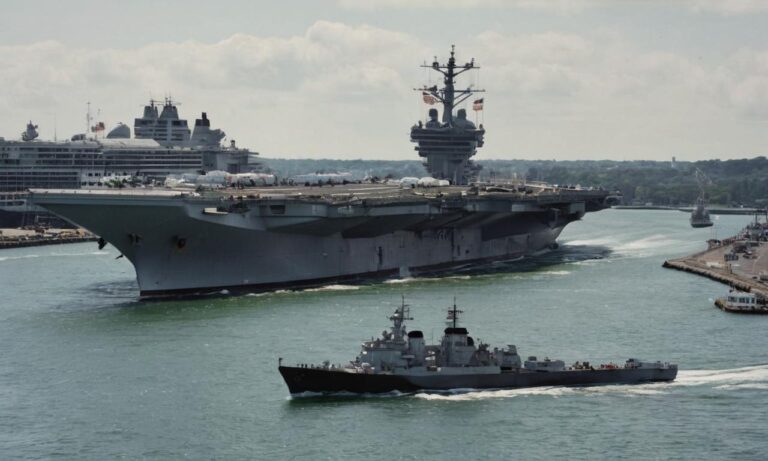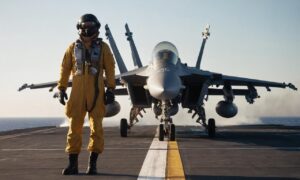Russia, a global military power, maintains a formidable naval force that includes aircraft carriers, crucial assets projecting power and influence across the seas. Understanding the number of aircraft carriers in Russia’s possession provides valuable insight into its maritime capabilities and strategic reach.
As of the latest available information, Russia currently operates only one aircraft carrier in its naval fleet. This sole aircraft carrier is the Admiral Kuznetsov, a powerful and versatile vessel that plays a pivotal role in Russia’s naval operations.
The Admiral Kuznetsov: Russia’s Sole Aircraft Carrier
The Admiral Kuznetsov, a Soviet-era aircraft carrier, serves as the flagship of the Russian Navy. Commissioned in 1990, this carrier boasts a displacement of over 55,000 tons and is equipped with a variety of aircraft, including fixed-wing fighter jets and helicopters. Its primary purpose is to project air power, enhance maritime security, and support a wide range of naval operations.
Despite being the only operational aircraft carrier, the Admiral Kuznetsov significantly contributes to Russia’s naval capabilities, allowing the nation to assert itself in various maritime scenarios.
Russia’s approach to naval power involves a combination of a diverse fleet, including submarines, destroyers, and frigates, complementing its lone aircraft carrier. While possessing only one carrier may seem limited compared to some other naval powers, Russia focuses on maintaining a balanced and versatile naval force capable of addressing various geopolitical challenges.
It is worth noting that Russia has expressed intentions to develop and modernize its naval capabilities, including the construction of new aircraft carriers. These strategic plans underscore Russia’s commitment to enhancing its maritime presence and ensuring a robust defense posture in an ever-changing global security landscape.
Aircraft carriers play a crucial role in modern naval warfare, offering strategic advantages such as power projection, force deterrence, and rapid response capabilities. As geopolitical dynamics continue to evolve, the significance of aircraft carriers remains paramount in shaping maritime strategies and influencing international relations.
While Russia currently operates only one aircraft carrier, the global naval landscape is dynamic, and future developments may see an expansion of Russia’s carrier fleet. Monitoring these changes is essential for understanding the geopolitical implications and strategic positioning of naval powers.
Operational Challenges and Maintenance
Maintaining an operational aircraft carrier poses numerous challenges, from routine maintenance to unforeseen technical issues. The Admiral Kuznetsov, as Russia’s sole aircraft carrier, requires meticulous care and attention to ensure its readiness for diverse naval operations. Understanding the intricacies of carrier maintenance sheds light on the complexities involved in sustaining a key component of Russia’s maritime strength.
International Comparison of Aircraft Carrier Numbers
When comparing the number of aircraft carriers, Russia’s single carrier stands in contrast to the fleets of other major naval powers. A table highlighting the total number of aircraft carriers operated by countries such as the United States, China, and India provides a comprehensive overview of global naval capabilities. This international perspective underscores the varying approaches nations take to maintain maritime supremacy.
| Country | Total Aircraft Carriers |
|---|---|
| United States | 11 |
| China | 2 |
| Russia | 1 |
| India | 2 |
Frequently Asked Questions
-
Q: Is the Admiral Kuznetsov nuclear-powered?
-
A: No, the Admiral Kuznetsov is conventionally powered, relying on fuel for propulsion.
-
Q: What types of aircraft are deployed on the Admiral Kuznetsov?
-
A: The carrier accommodates fixed-wing fighter jets and helicopters, providing versatility in naval operations.
-
Q: Are there plans for additional aircraft carriers in Russia’s future fleet?
-
A: Yes, Russia has expressed intentions to construct new aircraft carriers as part of its naval modernization strategy.
Russia’s commitment to modernizing its naval capabilities extends beyond the number of aircraft carriers. Exploring the strategic implications of broader modernization efforts, including advancements in submarine technology and surface fleet capabilities, unveils the multifaceted nature of Russia’s approach to maintaining a robust and adaptive naval force.






